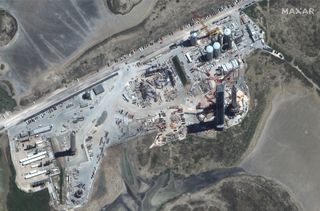
SpaceX's Super Heavy rocket looks big, even from space.
On Aug. 9, Maxar Technologies' WorldView-3 satellite snapped a great shot of SpaceX's "Starbase" facility in South Texas, where the company is building and testing its Starship deep-space transportation system.
SpaceX is developing Starship to take people and cargo to the moon, Mars and other distant destinations. The system consists of two fully reusable elements: a 230-foot-tall (70 meters) first-stage booster known as Super Heavy and a 165-foot-tall (50 m) spacecraft called Starship, which sits atop the huge rocket.
Photos: SpaceX lifts huge Super Heavy rocket onto launch stand

The WorldView-3 photo captures two different Super Heavy vehicles: Booster 3, which is resting on a suborbital launch pad near the left edge of the picture, and Booster 4, which is perched on an orbital launch mount at the right. Both vehicles cast long shadows, towering over the Gulf Coast landscape and most of Starbase's structures.
Booster 3 will never get off the ground. The 29-engine Booster 4, however, is being prepped for the Starship program's first-ever orbital test flight. The giant vehicle was hoisted onto the orbital launch mount on Aug. 5. A day later, technicians stacked the six-engine Starship prototype SN20 ("Serial No. 20") atop Booster 4, assembling the tallest rocket in all of history.
That same day, however, the huge duo was destacked, allowing SpaceX to perform additional work on Booster 4 and SN20.
Get the Space.com Newsletter
Breaking space news, the latest updates on rocket launches, skywatching events and more!
It's unclear when Booster 4 and SN20 will fly. SpaceX founder and CEO Elon Musk recently said that the duo should be ready to go in a few weeks, "pending regulatory approval."
That's a reference to the environmental assessment of the Starbase orbital launch site that's currently being conducted by the U.S. Federal Aviation Administration (FAA). And approval appears to be at least a month away, given that the FAA will accept public comments for 30 days after releasing its draft review, which has not yet happened.
WorldView-3, which is operated by Maxar subsidiary DigitalGlobe, launched to Earth orbit in August 2014. The sharp-eyed satellite is capable of resolving features as small as 12 inches (31 centimeters) on our planet's surface.
Mike Wall is the author of "Out There" (Grand Central Publishing, 2018; illustrated by Karl Tate), a book about the search for alien life. Follow him on Twitter @michaeldwall. Follow us on Twitter @Spacedotcom or Facebook.
Join our Space Forums to keep talking space on the latest missions, night sky and more! And if you have a news tip, correction or comment, let us know at: community@space.com.

Michael Wall is a Senior Space Writer with Space.com and joined the team in 2010. He primarily covers exoplanets, spaceflight and military space, but has been known to dabble in the space art beat. His book about the search for alien life, "Out There," was published on Nov. 13, 2018. Before becoming a science writer, Michael worked as a herpetologist and wildlife biologist. He has a Ph.D. in evolutionary biology from the University of Sydney, Australia, a bachelor's degree from the University of Arizona, and a graduate certificate in science writing from the University of California, Santa Cruz. To find out what his latest project is, you can follow Michael on Twitter.
